Presented at ETRIA World Conference TRIZ Future 2001, Held at Univ. of Bath, Bath, UK on November 7-9, 2001.
Editor's
Note (Toru Nakagawa, Dec. 17, 2001)
This paper by Poppe and Gras was presented at ETRIA World Conference "TRIZ Future 2001" last month. In my Personal Report of the ETRIA Conference, this paper was introduced as:Gert Poppe and Bart Gras [6] presented a clear and very useful paper for the application of TRIZ in the process industry. They first point out that process innovation predominates product innovation in importance in the latter half period of evolution of a technical system. Then they notice that many TRIZ novices in process industry regard TRIZ unapplicable to process innovation. Poppe et al. list up the apparent bases of such arguements, and then argue that TRIZ is very useful in process industry too. The authors has kindly agreed to repost their paper and some additional slides in my Web site. (Please be patient for a few weeks, my readers.)It is a great pleasure to be able to post this paper by courtesy of the authors. The authors sent me their paper and presentation slides via e-mail immediately after the conference. Four selected slides (of schematic diagrams of functional modeling and root cause analysis) have been inserted into the paper for illustration.We are grateful to the authors and ETRIA for their kind permission of posting this article here:
Authors: Dr. Gert Poppe (Innovation Quotient, The Netherlands): email: gert.poppe@innovation-quotient.nl
Mr. Bart Gras (Innovation Quotient, The Netherlands): email: bart.gras@innovation-quotient.nl
ETRIA (European TRIZ Association): http://www.etria.net/
| Top of this page | 1. TRIZ in Process Industry ? | 2. TRIZ in Process Industry ! | ETRIA Conference Personal Report (Nakagawa) | Japanese page |
TRIZ in the Process Industry
Gert Poppe and Bart Gras
Innovation Quotient
P.O.Box 170
5550 AD Valkenswaard
The Netherlands
www.triz.nl
Abstract
In recent years TRIZ has gained increasing interest in the manufacturing industry in the Western world. This interest is driven by different factors
including:Also in process industry, TRIZ interest increases. There are several points of attention, differing from product development, in applying TRIZ in
- Companies introduce product innovations faster and on the other hand have more difficulty to attract skilled R&D professionals.
- The availability of state-of-the-art software supporting the TRIZ methodology.
the process industry:In the article it will be described how TRIZ can be a success when applied to typical problems of the process industry.
- the ‘product’ is intimately linked to the process by which it is made. Any change in the product is mostly achieved by an adaptation of the process.
- the TRIZ knowledge base has initially been built on information contained in patents. But ‘kitchen secrets’ of how to produce a metal alloy or an engineering plastic are usually not patented.
- Causes of a problem in a process cannot easily be pinpointed. The problems can be tracked down to causes in areas like raw materials, chemistry, control loops etc.
1. TRIZ in the process industry ?
There is a very important reason to increase the insight into the possibilities of the TRIZ methodology for the improvement of production processes. As one can see in the figure 1, in the beginning of the lifetime of a product, one sees a high number of product innovations. As the product becomes more mature, the number of product innovations is reduced drastically, at least until a trend shift occurs. During this stage of the product (a major part of the life-cycle), improvements will mainly be achieved through changes and innovations in the production process. It would therefore be very unwise to limit the application of TRIZ to product improvements. This means that we will have to identify the reasons which, at first sight, hinder the application of TRIZ in the process industry. After this identification, we will have to find ways to overcome these impediments.
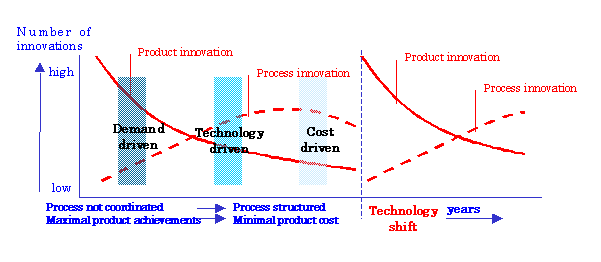
We will, in this paragraph, address the most important factors that seem to limit the use of TRIZ there :
1.1 TRIZ is based on an analysis of patents
TRIZ is based on an in-depth analysis of patents. These patents have led to the development of the different TRIZ-techniques e.g the 40 principles, the trends of evolution and the construction of the TRIZ knowledge base1). Typical about improvements in manufacturing processes is that these are often not patented. As long as it is not possible to see from properties (specifications, form, structure, …) of the product, what process change has brought about the improvement, companies tend not to make public (by patenting or otherwise) the ins-and-outs of this process change. Another reason why companies are reluctant to patent process improvements is that it is much easier to “work your way around” such patents than it is for product improvements.
Therefore companies in the process industry are not sure how they can benefit from a methodology that has the worldwide patent databases as its basis.
1) In the "TechOptimizer" software of Invention Machine this is called the "Effects database", in the IWB software of Ideation International "The innovation guide". The main fact is that an overview of physical and chemical effects to perform "basic" functions is an important part of TRIZ methodology.
1.2 TRIZ examples
are often “product” examples
Most of the applications of TRIZ published are
“product” application (see e.g. the TRIZ-journal). They focus on
improving a product by enhancing its useful functions or by eliminating
harmful ones. A major difference with “process” cases is that in
a process the substances that are introduced in the beginning of the process
undergo one or more changes before they form the product. These changes
can be: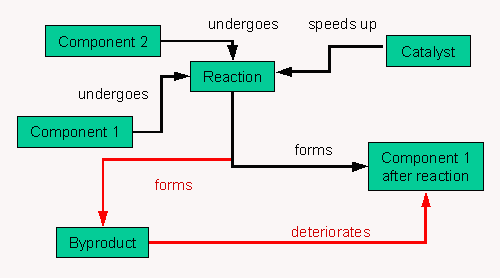
So, when applying TRIZ to manufacturing processes, extra care has to be given to the analysis and modeling stages. It would be very beneficiary if more elaborate examples of process problems solved with TRIZ would be published.
1.3 The real cause of a problem is often hidden somewhere in the process

The problems that occur in the functioning of
products, can often be pinpointed quite accurately. The specific
component in the product that is causing the problem most of the time is
immediately known after the problem is identified. In the process
industry however, the actual cause of a problem (the “root cause”) is often
hidden somewhere in the process. Off spec production, or an excess
amount of energy consumed, can be due to different kinds of root causes
somewhere earlier in the process. Off course there is a possibility,
when searching for solutions to the problem, to address each of the possible
causes one by one. But this will take a lot of time, because the
whole TRIZ process of analysis and idea generation in fact has to be repeated
once for every possible cause. In order for TRIZ to be efficiently
applied in the process industry, it will be necessary to address this complication.
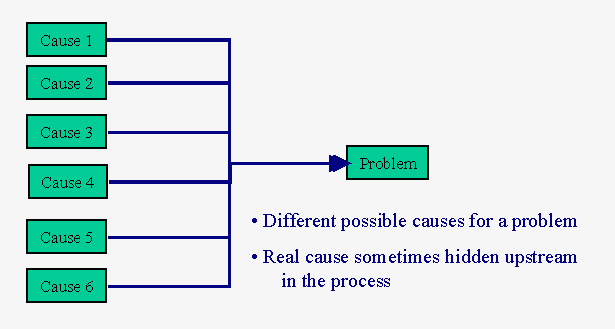
1.4 There exists an intimate link between the product and the process by which it is manufactured.
There exists an intimate link between a product and the process by which it is manufactured. This is off course the case in any kind of industry, but when the product that is being manufactured is a pellet, a powder or some other form of base product, that gets is use from the properties of the substance from which it is composed, any improvement in the product will have to be achieved by changes in the production process. In many cases this will not be achieved by interchanging one substance by another, but by changing the process parameters (pressure, temperature, …), the process operation or by trying to achieve other reaction mechanisms. In the process industry, it is not strange to say that “the process is the product”. This is off course the main reason why the process industry is called “process industry” in the first place.
For the application of TRIZ, this fact has to be combined with:
2. TRIZ in the process industry !
TRIZ is very successfully applied in the process industry. How is that possible, in view of the obvious objections raised in the previous paragraph. Below we will give a number of reasons for this.
2.1 Functional modeling and trimming
In product development, design and development methodologies are widely used. Functional modeling and functional thinking are known here through the application of these methodologies. Robust design, Value management, FMEA … in all of these methodologies “functional modeling” is used in some way. In the process industry, this is less the case. In the chemical industry e.g. it is much more common to think in “unit-operations” than to analyze the functions of the different components and substances in a process. So the mere introduction of “functional thinking” is very useful here. In TechOptimizer, the Process Analysis is focused on modeling the manufacturing processes. Here the functions can be given an additional tag:
To give a few examples.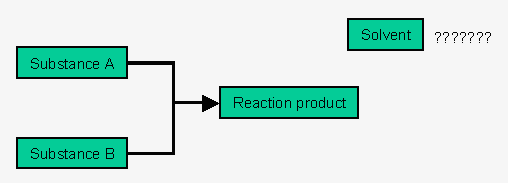
2.2 Root cause
analysis and problem analysis
As we already stated above, in processes the actual cause of a problem (the “root cause”) is often hidden somewhere in the process. Off spec production, or an excess amount of energy consumed, can be due to different kinds of root causes somewhere upstream the process. This means that the whole process of functionally modeling the problem at hand can become very complex. Indeed, the effort needed to model all possible areas or steps in a process where a possible cause of the problem is located can be huge. Also, TRIZ does not offer much support in dealing with this contradiction: on the one hand one would like to take all possible options into account, but then, on the other hand, time consumed by the process could become prohibitive. Or to state it in TRIZ terms: one wants to improve the reliability of the problem solving process by addressing all the possible causes but then the loss of time could become too high. The contradiction matrix in this case would suggest to perform a prior action.
This is a place where the Russian TRIZ methodology
can meet some of the Western methodologies. Root Cause Analysis (RCA),
Failure Mode and Effect Analysis (FMEA) and the Theory of Constraints (TOC)2)
are a few methodologies that can be combined with TRIZ, to achieve a more
efficient way of approaching the problems faced in production processes.
All these methodologies provide one with a way to relate a number of features
occurring in a process to the same “root cause”. 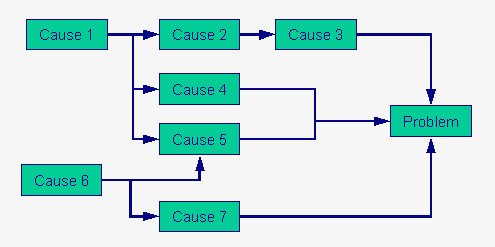 This
is mainly done through the development of Cause-and-Effect graphs, providing
insight in the way the “root cause” leads to the occurrence of the different
features. Before continuing with the TRIZ process, one has to determine
what the possible “root causes” of the deviations are and which of the
root causes is most likely to have produced the deviations. Furthermore
one has to decide at what level(s) of the Cause-and-Effect chain one wants
to focus. It is clear that in order to prevent e.g. environmental
contamination by a production process one can choose to:
This
is mainly done through the development of Cause-and-Effect graphs, providing
insight in the way the “root cause” leads to the occurrence of the different
features. Before continuing with the TRIZ process, one has to determine
what the possible “root causes” of the deviations are and which of the
root causes is most likely to have produced the deviations. Furthermore
one has to decide at what level(s) of the Cause-and-Effect chain one wants
to focus. It is clear that in order to prevent e.g. environmental
contamination by a production process one can choose to:
2) Ideation has developed, for the same purpose, Anticipatory Failure Determination (AFD).
2.3 Generic
knowledge in principles
But off course the best proof of the applicability of TRIZ in the process industry is the successful application of the different TRIZ tools to specific process related problems. Here we will give a few examples of how the 40 principles, one of the most widely used TRIZ tools, can be used.
Principle 34 : Rejecting and Regenerating Parts3)
Many chemical processes start with a reaction step during which the main product is formed as well as, unfortunately mostly inevitable, a number of by-products. In quite a few reactors these by-products have very negative consequences :Principle 5 : MergingPrinciple 34 could be used as a direction of improvement. If one could find a way of removing the primary product or (one of) by-products immediately after it has been produced, the unwanted effects stated above could be reduced drastically.
- Interaction of the by-products with the main product, thereby creating other by-product
- Deterioration of the catalyst used
- Exothermal by-reactions, which necessitates the use of cooling water and thus the destruction of (expensive) energy
3) We use the English formulation of the principles as they are stated in Altshuller's book "The 40 TRIZ Principles: TRIZ Keys to Technical Innovation". We believe that it would be advantageous if the TRIZ community would standardize the names of the 40 principles.
At the moment, several research projects are on, focusing on process intensification (see e.g. http://www.ncl.ac.uk/pin or http://www.bhrgroup.co.uk/confsite/pi01home.htm ). A main change in the process industry has been the identification of the fact that there exist “unit operations” which perform essentially the same function: distillation, reaction, exchanging heat, … This has lead to the development of generic systems that perform these functions. These systems where as independent as possible on the specific industry where they where applied: chemical, steel, food & beverage … Nowadays, one starts to learn that there is a lot to gain in process efficiency and /or the use of energy when combining several “unit operations” in one system. Examples are :Principle 31 : Porous materialBut it is certain more and more applications will rise from these projects. This is a very nice example of the application of principle 5
- Reactive distillation (already often used)
- Micro-reactors combining intensively a reactor and a heat-exchanger
- Dryer-granulators
The increasing use of membranes in extraction, cleaning and separation processes is one of the most clear illustrations of the fact that principle 31 is finding applications in the process industry.Trimming
“Trimming” (which can be viewed as a special application of the principle “Universality”) is a very important principle to apply in manufacturing processes. Very often, after identifying the cause of a process deviation or an unwanted by-effect in a process, additional equipment is installed to remove the cause. The problem with this type of solution is that one also introduces new possible sources of trouble.4) This can indeed lead to a situation in which additional equipment is used to reduce the effect of problems that are the result of the fact that additional equipment is used to reduce the effect of problems that are the result of the fact that … A way to overcome this is to consider “trimming”: remove (components of) the system so that one gets rid of its harmful effect (causing the process deviation) and try to transfer its useful effects to already existing (components of) the system. Off course that will not be possible in every case but very often “trimming” is an option that is not even taken into account when trying to resolve a process deviation.The use of this principle in the process industry has also been illustrated already in section 1 of this chapter, when we discussed the use of transportation means for performing other functions
4) This is excellently illustrated in "Edge suck off: towards the ideal system", by Ian F. Mitchell of Illford Imaging published in the May 2000 item of the TRIZ-journal.
These examples primarily illustrate the fact
that the TRIZ principles, although (as we stated before in this article)
derived from patents which usually deal with product innovations, are generic
enough to be used for improvements in manufacturing processes.
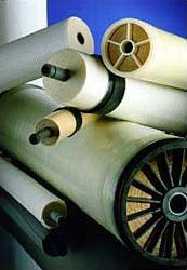
Biography of the authors
Gert Poppe
37 years old. PhD in Physics.Bart Gras
Worked as a knowledge engineer at DSM Research, where he introduced TRIZ.
4 years of TRIZ experience, both within the process industry and in other areas of industry
Email : gert.poppe@innovation-quotient.nl
39 years old. Applied mathematical engineer.
Worked as a knowledge engineer at DSM Research and later at Bolesian, a company focused on knowledge based technologies.
2 years of TRIZ experience, both within the process industry and in other areas of industry
Email : bart.gras@innovation-quotient.nl
| Top of this page | 1. TRIZ in Process Industry ? | 2. TRIZ in Process Industry ! | ETRIA Conference Personal Report (Nakagawa) | Japanese page |
| Home Page | New Information | Introduction to TRIZ | TRIZ References | TRIZ Links |
| TRIZ News & Activities | TRIZ Software Tools | TRIZ Papers and Tech Reports | TRIZ Forum |
Last updated on Dec. 17, 2001. Access point: Editor: nakagawa@utc.osaka-gu.ac.jp